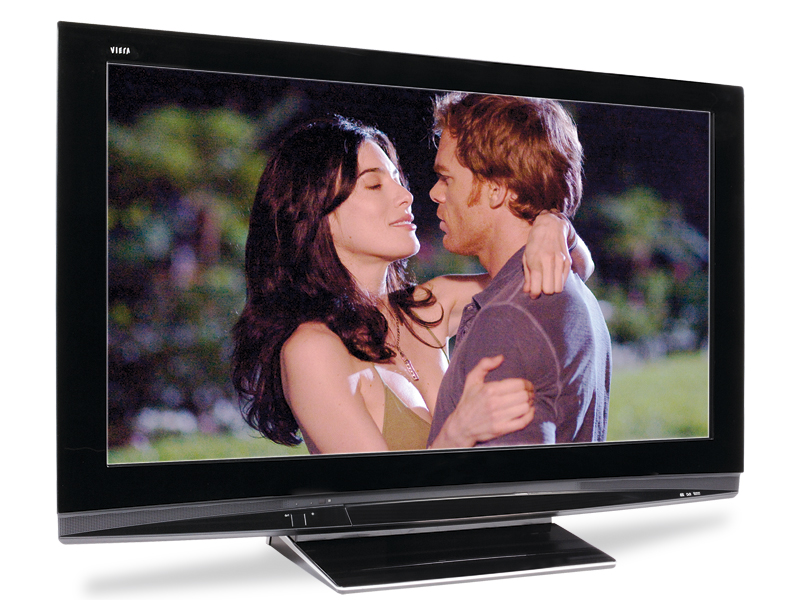TechRadar Verdict
A multi-talented and fully-featured TV
Pros
- +
Three tuners including HD sat
- +
Basic multi-sat support
- +
Easy setup
Cons
- -
No motorised dish support
- -
Freeview EPG looks bland compared with Freesat
Why you can trust TechRadar
The first range of Freesat-receiving (including HD) TVs to appear is Panasonic's PZ81 plasma range, which comes in three sizes - 42in, 46in (about £1,600) and 50in (about £1,800) and, for those whose Freeview/aerial coverage isn't entirely non-existent, also boasts DTT and analogue tuners.
It's a good-looking set in reflective piano-black with a bezel that curves elegantly at the bottom, where you'll find the operating buttons and concealed front AV sockets which include one of the three HDMI ports (the others are on the rear).
Plentiful features
It can be wall-mounted with an optional bracket or left sitting on its sturdy square stand, which resembles a pair of fetching bathroom scales. It's not the thinnest TV we've come across but is still slender considering what's inside it.
Nestling amid the connections on the rear are a single downward-facing LNB input accompanied by a CI slot which, with the addition of CAMs and cards, can be used for terrestrial and satellite (but not Sky) pay-TV reception.
In line with standalone Freesat receivers, there's also an Ethernet port ready for future on-demand services.
The remote conforms to the current standard simple but intuitive Panasonic design, with no dedicated buttons for the satellite side of things - although this doesn't cause much of a problem. You can also use it control other HDMI-connected Panasonic devices using the Viera Link system.
Setting up Freesat
Our preview sample was a pre-production model without finalised software but, even so, we encountered no bugs to speak of.
On first start-up the TV automatically scans for channels on Freesat, then DTT, then analogue. It took under 30 seconds to scan Astra 2 and Eurobird - much quicker than the first wave of Freesat boxes.
Switching between the tuners is a matter of pressing the TV button on the top right-hand corner of the remote and selecting the one you want.
You can then create a single favourites list for each tuner (rather stingy for satellite if you plan to look further afield than Astra 2 and Eurobird) and DTT and Freesat both get their own tailored EPGs.
EPG options
The Freesat effort is on a par with the Humax Foxsat-HD receiver, displaying a grid of channels alongside data for each in landscape mode.
In portrait mode you can view a row of channels along the top with lists of programme data for each underneath. You can opt to view data for channels according to genre (entertainment, news, sport) or to only view listings of programmes of a certain type.
You can also set up timers and reminders and skip back and forth 24 hours with one button press.
The programme information bars display now-and-next information only and are identical for each tuner save for the top-left corner where you'll find displayed 'FS' for Freesat, 'DVB for DTT and 'A' for analogue.
Other services
Scroll through the menus and you'll find 'Other Sat. Services'. There's no provision for motorised dish users, but 22kHz switching is supported.
There's an automatic scan option for Astra 1 and Hot Bird and you can manually tune channels by entering frequency and polarisation and choosing from three symbol rates: 22000, 27500 and 29500.
But you can't sort non-Freesat channels by genre, nor will you be able to use their interactive services.
Fantastic picture performance
Picture-wise, performance is excellent across the board, with the panel delivering faithful colour reproduction and realistic contrast levels.
Standard-definition pictures display little noise even on analogue terrestrial feeds to the extent that we sometimes forgot we were watching the latter.
On the HD front, watching footage of last year's Wimbledon tournament on BBC HD we could clearly pick out fine details in the net and the sweat on players' brows.
In all, the PZ81 range looks like a capable, well-considered all-in-one digital TV provider and a high-performing plasma TV in its own right.
